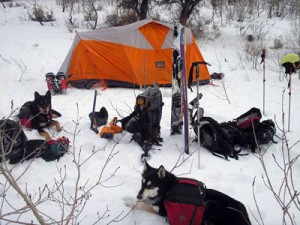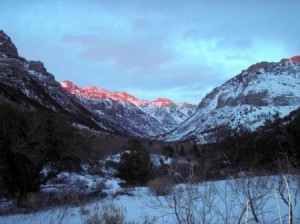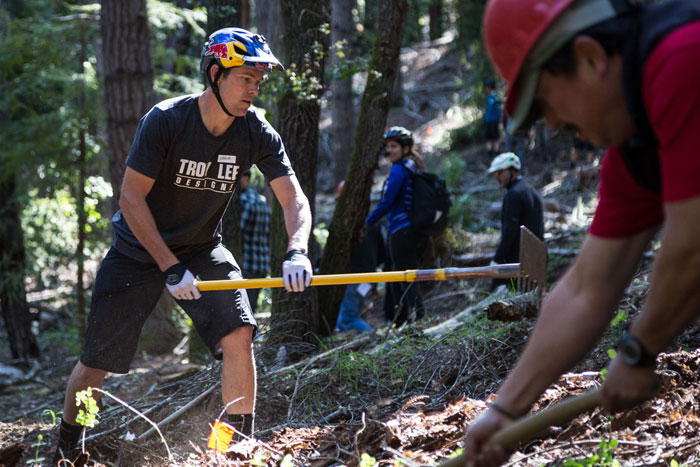- Tahoe’s Nevada Beach Tops the List of Hard-to-Book Campgrounds - 07/17/2024
- Cannabis Watershed Protection Program Cleans Up Illegal Grow Sites - 07/10/2024
- French Fire - 07/05/2024
Is it worth the long drive to Nevada’s Ruby Mountains for backcountry skiing? A Tahoe couple goes in search of a legendary couloir
Story and photos by Brennan Lagasse
About halfway between Tahoe and Salt Lake City lies the hidden gem known as “the Rubies.” Unless you’ve traveled I-80 through the Nevada desert on a clear day, the only way I bet you’ve heard of the Rubies is because there’s a heli-op.
It’s true. That’s actually one reason I always have questioned going. Imagine skinning all day, only to be a few hundred feet away from the top of your objective — and then a helicopter lands on the peak and your hard-won line gets poached!
Not the sort of daydream that usually gets us to visit epic backcountry locales. Take that thought and add snowmobiles racing up and down the access road to some of the best backcountry skiing, and there you have why it’s been so easy for me to put off this trip across the Nevada desert.
The funny thing is, my fears were justified — but we found amazing turns anyway. The heli was flying for the few days we were out there, and in Lamoille Canyon, snowmobiles rule the right of way on the flat access road.
The thing is, if you ski where the heli isn’t taking clients, and where the snowmobiles can’t climb the steeps, those “problems” are solved. Actually, we barely saw the heli at all, and the snowmobilers were super friendly, watched out for our dogs, and didn’t really venture off the beaten track.
A road that gets covered for most of the winter bisects Lamoille Canyon. After leaving I-80 in Elko, and stocking up on supplies, it’s a quick 30-minute drive southeast to the access road. As the pavement ends, the road continues five miles to the head of the canyon. This is where most of the snowmobilers go, passing up several points to peel off the road, all which offer amazing skiing.
A local told me a lot of snowmobilers ski and use their sleds to access the higher elevation bowls, chutes and ramps at the end of the unplowed road (8,800 feet). “That’s where most people ski” is what we were told. “There are a few other trailheads to the north, south, east and west, but this is where the best skiing is.”
_____________________________________________________________________________________
“The aesthetics of the couloir are impossible to ignore; a consistent fall line that forces you to be in rhythm and control with each turn.”
_____________________________________________________________________________________
While our objectives included a recon of the area, to see what stashes were available, and if they were worth the five-plus hour drive from Tahoe, we also had a certain line in mind.
Noted ski mountaineer Andrew McLean once wrote a story of his “deepest day ever.” Now, the phrase “deepest day” carries weight regardless of who is saying it. But when McLean said his deepest day was in a couloir that was 20 feet wide for the better part of its length, in the Rubies, I did everything I could to find beta on the line and make it a must for our trip.
It turns out the line is called Terminal Cancer (TC). I know, it is a horrible name for such an aesthetic line, but that was our main ski goal beyond just getting a feel for these new mountains in a new place.
Jillian and I had loaded the overnight gear, and got the dogs ready with their own packs. We started skinning on the access road, knowing at some point TC should be off to our right and was apparently impossible to miss. I had studied the few pictures I could find, and figured it’d be a few hours to skin to the base of the couloir, where we’d set up camp.
Did I say a few hours? I meant a few minutes.
Here’s when the lack of beta laughed at me in the face — the line came into view about 10 minutes from the car! I guess the access road was plowed a bit further than I expected.
Regardless of where you start skinning from, once you’ve got TC in your sights, it’s a short skip over the creek and before you know it, you’re climbing. It caught me so off guard I actually questioned if it was the right line at first. At least it wasn’t a few days to get out there (like I planned for), but it was pretty funny to be dialed for a few nights of winter camping only to set up 30 minutes from the car on day one.
I know it sounds corny, but that night we were treated to a beautiful sunset, with such a ruby glow it would’ve made indulgent businessmen amend their capitalistic ways.
The next morning we were treated to a glorious, unique couloir with 4-6 inches of soft powder perfectly coating the tight corridor. All four of us fit in the walls, and the dogs even stayed just far enough back of the lead skier so as not to prompt me or Jillian to use our “doggy skiing voice,” which sometimes causes people who don’t know us to think something horrible is happening. The line skied at a high 30-degree angle, which made it totally fine for the dogs, but still super fun for us.
Dropping in, the aesthetics of the couloir are impossible to ignore; a consistent fall line that forces you to be in rhythm and control with each turn. The walls glow, and the tightness of your passage only emphasizes how distinctive this line truly is.
But don’t let the narrow confines of TC scare you off. It’s really not that steep. Add in some fresh snow and you have one of the most beautiful, gnarly looking lines in the Lower 48 that in reality is not that puckering to descend or as lethal as its name implies. If you’re claustrophobic, maybe you should reconsider, but for the rest of you, it’s really tough to beat the walled snow alley of a freshly coated TC.
I’d say your main concern, if you are up for skiing complex terrain like this, is making sure the line itself is stable. That is to say, there is little danger from the neighboring walls letting loose any slough into the couloir.
The rest of our time in the Rubies was spent gawking at what seemed to be endless possibilities. Every few hundred feet unveiled a new vantage point as we ascended the access road. The level of difficulty was as diverse as the canyon itself, varying between lines that had closeout airs in the middle, to big 20 degree ramps and bowls that looked like powder magnets.
While I’m not sure if I’d tell you to pass up a trip to Tahoe or Salt Lake for a chance to hit the Rubies, I’d without doubt tell you to at least work in a day or two. The Rubies live up to their name as a “gem” hidden in the rough of the Nevada desert. They are definitely worth a visit, and are definitely worth leaving some tracks.
If You Go:
* If you’re a backcountry skier without a snowmobile you will be in the minority. Just keep an ear out, let ’em pass, and all will be good.
* is close, and kind of weird. Definitely worth a visit for a beer and some grub on the way in or out. It’s also your best bet for gas, food, random supplies, and getting weird looks for not fitting in (or being a cowboy).
* The snowpack in the Rubies is unique. Super light, dry snow. More like the Wasatch than the Sierra. Lots of signs of instability strewn about Lamoille Canyon (at least when I’ve been there). Be cautious and make safe decisions.
* Lamoille Canyon is just the tip of the iceberg. Get a topo map and ponder the possibilities. The Rubies are 80 miles long with a number of peaks topping 11,000 feet.
* If there’s been a bunch of new snow, expect much longer approaches to the mouth of Lamoille Canyon via an unplowed access road (unless you have a snowmobile).
* Terminal Cancer is worth a trip to the Rubies, all by itself.
Brennan Lagasse is a writer, teacher and mountain guide living in Lake Tahoe. No longer averse to heli ops, this season he’ll be guiding a first of its kind heli-accessed ski touring program in the Chugach Range of Alaska with Points North Heli-Adventures, www.alaskaheliski.com/experience/heli-access-ski-touring/.















